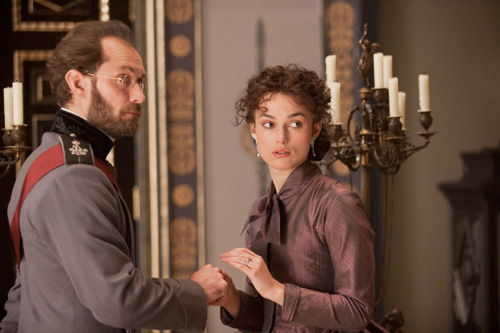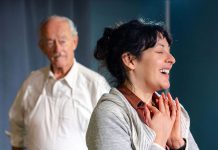Joe Wright’s “Anna Karenina”
Joe Wright’s Anna Karenina is an amazingly beautiful film—but weird—in the same artistic sense that Baz Lurmann’s Moulin Rouge was weird. Wright’s film opens showing a proscenium arch in a nineteenth century Russian theater, the curtain rises, and the action begins. Throughout the film, we witness things happening as if they were onstage, in the rafters above the stage, or in the audience. Other times, we are in a “real” room or wheat field or snowstorm. This style of moviemaking is very original, but obviously very confusing to people in the audience.
Leo Tolstoy’s story, which the Russian author wrote in serialized installments from 1873 to 1877, is (depending on one’s point-of-view), either a scandalous tale of adultery or a tragic love story. The title character is a Russian socialite married to a respected Tsarist statesman twenty years older than she. The film opens with Anna (Keira Knightly), traveling to Moscow for the debutante season. Dolly (Kelly Macdonald), Anna’s sister-in-law, has just discovered her husband’s affair with their governess. “You must find it in your heart to forgive him,” Anna advises. “For if not, you will have nothing.” This provides the film audience with necessary information about Anna’s mindset and the patriarchal rigidity of Russian divorce laws.
The stage for what follows has already been set. On the train, Anna literally bumped into Count Alexi Vronsky (Aaron Taylor-Johnson), a wealthy cavalry officer with piercing blue eyes, curly blonde hair and mustache, and a manly swagger. When the count appears at Princess Kitty’s (Alicia Vikander) debutante ball, the 18-year-old assumes he is there to woo her. Instead, Vronsky dances almost every waltz with Anna, and the evening rushes past in a whirl of brass-buttoned uniforms, ball gowns, languid arm movements, gleaming smiles, and fancy footwork.
Confused by her own passion for Vronsky, Anna boards the first train back to St. Petersburg, only to find that the Count is on board as well. He manages to get Anna alone in the train corridor, and professes his undying love (and lust). With conflicting emotions, Anna returns to her husband Alexi’s (Jude Law) house and bed.
Another story parallels Anna’s and Dolly’s tales: just before Kitty’s debutante ball, a smitten suitor, Kostya Levin (Domhnall Gleeson), literally gets down on his knee to propose. Flustered, Kitty tells Levin “No,” and the heartsick man returns to the family acreage where he toils alongside his serfs to try and forget this rejection.
This all occurs in the first half of the first section of the eight section novel—which gives you a slight idea of the gargantuan task screenwriter Tom Stoppard (“Shakespeare In Love”) had in adapting this sprawling story for the screen.
It is, however, Joe Wright’s very personal concept of Anna Karenina we see. Previous films from the same director include the Jane Austen period drama “Pride and Prejudice” (2001); the lying-girl-sends-her-tutor-to-prison-out-of-spite movie “Atonement” (2007); the former child violin prodigy, now a homeless LA beggar story “The Soloist” (2009); and the girl raised by her ex CIA father in ice-covered Finland to be an assassin, fairy-tale, “Hanna” (2011). People searching for a directorial “style” in these disparate projects point out that Wright likes to use extended tracking shots to frame scenes as though they were classic paintings. When he was told this, Wright famously replied, “Basically, I just like showing off.”
As noted above, Wright’s “showing off” in Anna Karenina puts many audience members (and critics) on edge. It also directly contradicts another of Wright’s famous quotes, that his movies are “all about bums on seats.”
The couple sitting next to me at the screening explained before the lights dimmed that he “owed” her a “chick flick.” As they were leaving, I overheard him say, “Now you owe me two action films.”
Comments? E-mail gi*********@*****st.net.








